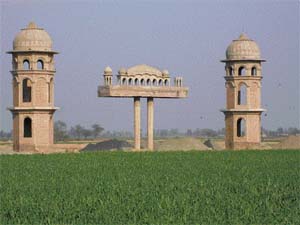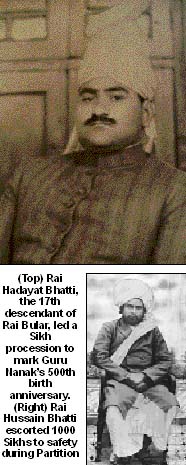Rai Bhoe Di Talwandi, originally called Raipur, is named after Rai Bhular's son by Alla-ud-din Khilji. It is the birthplace of Guru Nanak Dev ji. It is where the Nankana Sahib Gurdwara is located.
------------------------------------------------------------------------
Guru Nanak’s estate flourishes in Pakistan
The Bhattis of Nankana Sahib in Pakistan are keeping alive their 500-year-long family tradition of strengthening Sikh-Muslim ties. Naveen S. Garewal visits the Muslim family, whose ancestor Rai Bular Bhatti was the second disciple of Guru Nanak

Rai Bular Bhatti’s haveli in Nankana Sahib was frequented by Guru Nanak during his childhood
Blessed by Baba Nanak, the Bhatti family of Talwandi (now Nankana Sahib) has been a shining example of Muslim-Sikh brotherhood for over half a millennium. Rai Bular Bhatti, a contemporary of Guru Nanak Dev and a devout Muslim, became Guru Nanak’s second disciple. After Bibi Nanki, Guru Nank’s sister, he was the second person to recognise that Guru Nanak was no ordinary mortal and that he was a divine soul.
Blessed by Baba Nanak, the Bhatti family of Talwandi (now Nankana Sahib) has been a shining example of Muslim-Sikh brotherhood for over half a millennium.
Rai Bular Bhatti, a contemporary of Guru Nanak Dev and a devout Muslim, became Guru Nanak's second disciple. After Bibi Nanki, Guru Nank's sister, he was the second person to recognise that Guru Nanak was a divine soul.

One of the objectives of the now defunct Nankana Sahib Foundation was to spread Guru Nanak’s teachings
Sakhis, pertaining to the life of Guru Nanak, feature Rai Bular repeatedly. In the sakhi where villagers are furious about Nanak's cattle eating their crop, it is Rai Bular who got the crop surveyed and found it to be undamaged. In yet another sakhi, Rai Bular is said to have spotted a hooded cobra providing shade to the sleeping Guru Nanak. This strengthened his belief that Guru Nanak was no ordinary mortal.
The blessings the Bhatti family received have seen them prosper through 19 generations in five centuries.
Today when the world is getting divided on religious basis, the children of Rai Bular Bhatti continue to carry on the tradition of the Bhatti clan. An important functionary of the now defunct Nankana Sahib Foundation, the late Rai Bashir worked hard to build an institution on the 10 acres donated by his nephews Rai Sarwar Khan and Rai Ahmed Khan. He laid the foundation stone of the complex in June 1994.
Even though Rai Bular's family is today scattered all across the world, his descendants are actively involved with the promotion of Muslim-Sikh brotherhood. The family has kept alive their ancestral links with Gurus. Despite being devout Muslims, the family has emotional and spiritual attachment with Sikhism for the past several generations.
The Adi Granth translated into English from Gurmukhi by Dr. Ernest Trumpp finds repeated references to Rai Bular. Members of the Bhatti family make special efforts to participate in all Sikh celebrations. They especially came from Pakistan to take part in the tercentenary celebrations of the birth of Khalsa at Anandpur Sahib some time ago. They are bestowed the honour of leading the religious processions held at Nankana Sahib each year to celebrate the birth anniversary of Guru Nanak.
According to historians, originally, the Rais were Bhatti Rajputs and Rai Bular, a contemporary of Guru Nanak, was the ruler of Rai Bhoe di Talwandi where Nankana Sahib is now located. Mehta Kalyan Das (Kalu), a well-read person of Bedi caste, was an employee of Rai Bular. Nanak was born to Mehta Kalu and his wife Mata Tripta in 1469, at a place now known as Janam Asthan in Nankana Sahib town, which is now also a district.
According to the ancient revenue records in possession of the family, Rai Bular gave 247 murabas of land to Gurdwara Janam Asthan along with an annual jagir of Rs 9996. He also gave another 220 murabas to Gurdwara Bal Lila and extended an annual jagir of Rs 31 and another 290 muraba and annual grant of Rs 50 to Gurdwara Mal Sahib. This entire land of Nanakana Sahib given to Guru Nanak by Rai Bular amounts to 757 murabas (approx. 18,750 acres) and is now controlled by the Evacuee Trust Property Board of Pakistan and leased out to the people of Nankana Sahib.
Rai Bular chose to give his most fertile agricultural lands to Guru Nanak after he discovered Guruji's divine powers. It is on this land, and on the exact spot where Guru Nanak was born, that Gurdwara Janam Asthan was built by Maharaja Ranjit Singh.
Maharaja Ranjit Singh, incidentally, also had the same lineage as the Bhattis, who were direct descendants of Raja Rai Bhuni Khan — whose one son Rai Sanspal was the ancestor of Maharaja Ranjit Singh, while the other son Raja Manpal was the ancestor of the Bhatti clan. This fact finds mention in Tarik-e-Bhattian, a book on the history of the Bhatti family.
Today the Nankana Sahib Estate consists of about 16,962 acres, mainly leased to farmers and residents of Nankana Sahib. Almost all houses in Nankana Sahib are built on the property donated by the Bhatti family. "Babaji" (as Guru Nanak is affectionately called by the Bhatti family), says Rai Mohammad Saleem Akram Bhatti, the 19th generation descendant of Rai Bular, "is revered by all of us as our father."
The family had directly managed and looked after this property on behalf of Guru Nanak many years after him by the successive heads of the Bhatti family. Father-son duo Rai Rehmat Khan and Rai Anayat collected revenue after the Partition and deposited it with the Gurdwara Management, which was in turn used for the welfare and development of local Sikhs and the seven gurdwaras in Nankana Sahib.

The Rai Bular family has maintained the highest traditions of Muslim-Rajput culture. It is said that during the Partition, Rai Hussain, father of Rai Bashir, personally escorted to safety over 1,000 Sikhs during the Partition. Heartbroken by the Partition and the massacre of thousands of lives, he passed away in 1948.
The earliest historical reference to the city of Talwandi (now Nankana Sahib) is found in ballads. There’s mention of the first siege of Jaisalmer that occurred during the reign of Alla-ud-din Khilji (1295-1315). Khilji's Army had attacked Jaisalmer, a state in Rajputana, to avenge raids by Rajputs. It is said that after a bloody battle, one of the Bhatti Rajput prince who survived was taken hostage. He was sent to exile somewhere north of Punjab, near Kotli (about 40 miles from the present-day Lahore).
Folklore has it that Alla-ud-din Khilji was so touched by this boy's bravery that he paid a tribute to the young prince by giving him about 1,50,000 acres of Punjab's most fertile land as compensation for his loss and also as an enticement to keep him from rallying troops and building a new Rajput Bhatti Army. This exiled prince is said to have named the place Raipur and later Rai Bhoe di Talwandi (after his son). Nankana literally means Nanak da ana or the coming of Nanak.
In early 1994, a move was initiated to set up the Nankana Sahib Foundation. The purpose of the trust, which was to come up at Kot Hussain Khan, about 5 km from Nankana Sahib, was to generate revenue for the maintenance Nankana Sahib. The Bhatti family donated 10 acres for the same, but the Pakistan Government of Benazir Bhutto did not give permission for the trust and today the place has only a gate at the site.
Since almost all houses of Nankana Sahib are built on the property given to Guru Nanak by the Bhattis, the Nankana Sahib Estate is the property of the Nankana Sahib Gurdwara (Gurdwara Janam Asthan) and it cannot be sold to anyone. Today, about one lakh people reside on this property.
Though all members of the family have always been close to the Sikh community, Rai Hadayat Khan Bhatti, the 17th descendant of Rai Bular, deserves a special mention as he devoted a lot of time to strengthening Sikh-Muslim relations. He led the Sikh procession on the occasion of the 500th anniversary of Guru Nanak. He inculcated the spirit of service in his two sons, Rai Aslam Bhatti and Rai Akram Bhatt, who conducted Sikh pilgrims to the gurdwara and invited them for food at their house.
Rai Akram Bhatti, a practising lawyer at Nankana Sahib welcomes Sikh pilgrims with open arms to his house. His faith in Sikhism is so strong that he says that he owes the birth of his elder son Rai Mohammad Saleem Akram Bhatti to the blessings of Baba Nanak. Saleem, a young criminal lawyer at the Lahore High Court, says: "It is because of Baba Nanak that I am in this world. For us Babaji has a special place in our lives and our family is blessed because of the grace bestowed upon us by Baba Nanak."
Talking about the Muslim-Sikh ties the family has upheld over the centuries, Rai Akram Bhatti says that Rai Hussain Bhatti was awarded the highest honour for his generosity, leadership, public service and vision by Queen Victoria at the golden jubilee celebrations of her coronation in 1887.
Maharaja Ranjit Singh, too, had acknowledged the role of this extraordinary family and its immense contribution to Sikhsm. Ranjit Singh bestowed upon Rai Issa Khan (15th generation) the title of Rai Bhadur and he was made the in charge of a sub-jail in Thatta Issa village. He was also He was also appointed honorary magistrate and given the duty to collect the revenue.
"Militancy in Punjab in the 1980s had a direct impact on the pilgrim flow to Nankana Sahib. We are happy that with the return of peace, the number of pilgrims has risen, giving the Bhattis an opportunity to serve them," says Rai Akram Bhatti.
— Photos by the writer


